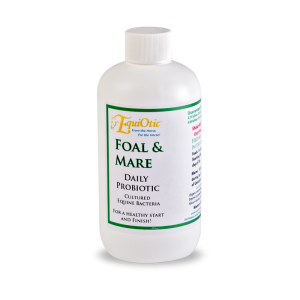Equine
EquiOtic Foal & Mare Protocols
Give your foals a healthy start! Starting the foal with an initial flora from the mare is critical to neonatal health.
Three major sources for flora are:
- the birth canal
- sucking the mammary gland (beneficial bacteria inhabit the teat canal of the mare)
- the environment
Pediatric diseases can be greatly influenced by the GI flora. Therefore, to support adequate presence of equine Lactobacillus Reuteri you can supply it with the pre-foaling addition of this beneficial bacteria to the mare and supporting the GI tract of the foal through perinatal period. This is why we recommend to start the mare on Equiotic Foal & Mare, or Equiotic daily packets, during the last month of gestation.
We have added an exciting new protocol option for our Foal & Mare product. This was developed to help make feeding easier for large busy farms. The daily protocol is still a great option for farms that are already working with foals on a daily basis.
Weekly Protocol Feeding Directions: (shake well before each feeding)
Mare – give 30 cc (37.58 B cfu) 30 days prior to expected foaling and then 30cc once weekly up until birth. For Mares the Equiotic Foal & Mare can be syringed into their mouth or added as a top dress onto feed.
Foal (post foaling) – give 10cc (12.5 B cfu) once daily for 5 days. Give first dose to foal after ingestion of colostrum
Foal (growing) – give the foal 40cc (50 B cfu) weekly starting at around one week of age and continue to give 40cc weekly for 6 months, through weaning.
Daily Protocol Feeding Directions: (shake well before each feeding)
Mare – give 10 cc (12.5 B cfu) daily during the last 15 days of gestation. For Mares the Equiotic Foal & Mare can be syringed into their mouth or added as a top dress onto feed.
Foals – give 3 cc (3.75 B cfu) daily through weaning. Give first dose after ingestion of colostrum
In addition to the Equiotic Foal & Mare product we also recommend to add in 1 scoop of Equibios twice a day for 7 days after birth. The Equibios contains large numbers of Saccharomyces boulardii that acts to bind to pathogens and prevent them from attaching to the mucosal surface and inhibition of clostridial toxins.

